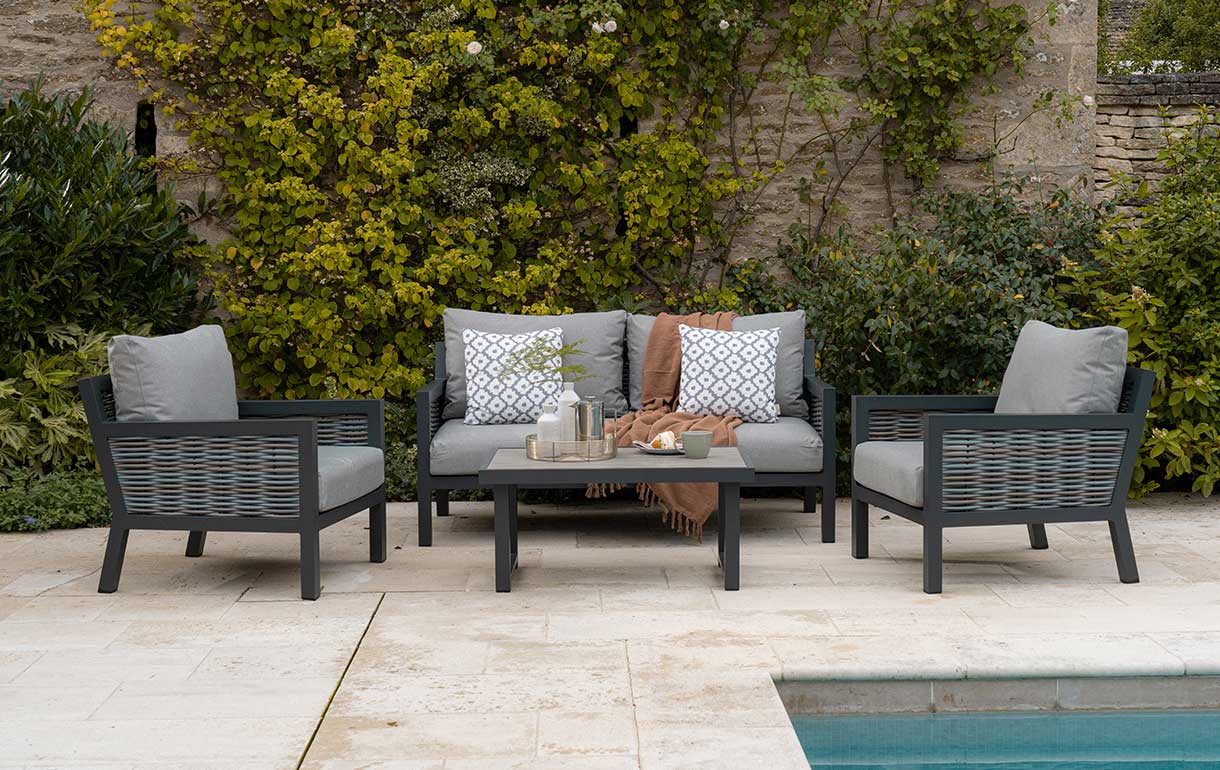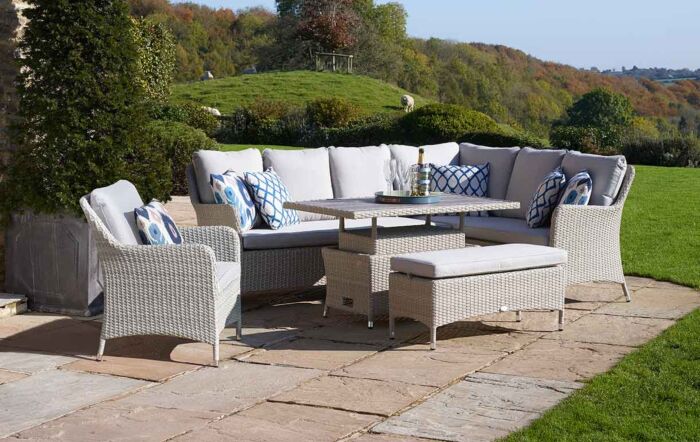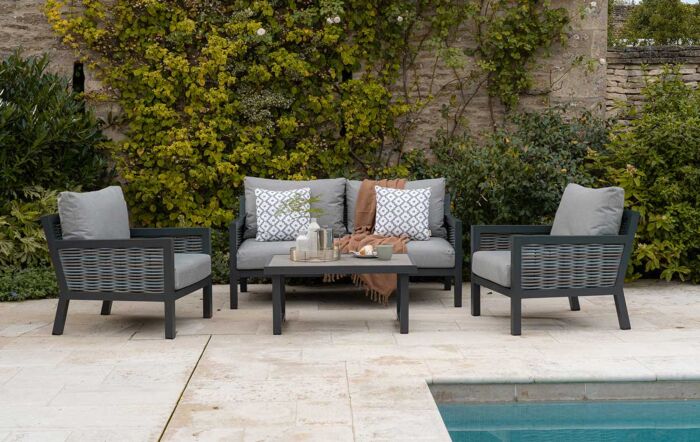What’s the Best Way to Care for Different Types of Garden Furniture?

The best way to care for different types of garden furniture is to work out what they each need you to do and when. You want your garden furniture to last a few years and keep looking as good as new, particularly if you’ve invested in high quality brands.
The choice of furniture for your outside space may be varied but, generally, high quality sofas, chairs and tables are made from just 4 basic materials: synthetic rattan, wood (particularly teak), metal (such as aluminium) and, of course, soft upholstery.
Caring for high quality garden furniture is quick and easy if you understand a little about the materials being used, and take note of some basic rules.
Basic care for different garden furniture materials
The first rule in caring for different types of garden furniture is to always follow the manufacturer’s assembly and care instructions. Even the most basic assembly can result in unnecessary wear and tear if you get it wrong. For example, not tightening the nuts and screws when attaching chair legs will cause movement that might even become a safety issue.
Most manufacturers will also recommend how to clean their furniture. Check leaflets, tags, labels or online just in case they have some very specific guidance. Alternatively, our experience with the top garden furniture brands means we can point you in the right direction.
Your first task will always be to carry out regular checks for food, drink, mildew and general dust gathering on your furniture. Then set about cleaning it off as soon as possible.

How to care for rattan garden furniture
Synthetic rattan has a very easy care routine. First, use a vacuum cleaner, or stiff brush, to remove loose bits of dirt and food from the weave. Be gentle so you don’t ruin the weave. Then, use warm, soapy water to remove any stains from food and drink. As soap will leave a residue, be sure to rinse it off with fresh water. If you are using a hose make sure it’s not set to a high pressure - again, so you don’t harm the weave. Finally, remove any excess water and leave your rattan furniture to dry naturally. Ceramic and glass table tops can also be cleaned with soapy water, then rinsed. Dry and polish your table tops with a soft cloth to remove water ‘rings’.
The top brands of rattan garden furniture are robust enough to withstand reasonable use without any maintenance – they're designed to stay outside all year. Alternatively, use custom made covers for garden furniture that protect your furniture from the worst of the weather while allowing a certain amount of air to flow round.

How to care for aluminium garden furniture
Aluminium is an ideal material for garden furniture. It looks good, is very lightweight, and durable enough to be left outside without it rusting. Also, lift the furniture instead of dragging it over hard surfaces, such as a stone patio. This will protect the feet from being scuffed.
To clean your aluminium garden furniture, simply use a mild detergent and lots of warm water to remove dust, dirt and stains, then rinse and leave to dry. For stubborn stains just use a brush to lightly scrub the area.
Regular cleaning of your aluminium furniture will prevent the build-up of dust and dirt, helping to keep it looking as good as new. If your aluminium furniture comes ready powder-coated, then it will be well-protected against even the harshest weather such as salt water in coastal regions.

How to care for teak garden furniture
Teak furniture is easy to look after and doesn’t require a lot of care due to its high oil content. Give it a yearly scrub with soapy water, followed by a thorough rinse. This removes any dirt and restores the timber's surface.
If you opt to use a furniture cover please regularly air your wooden garden furniture, as teak is a natural product it needs to breathe. This will help to prolong its colour. Otherwise it will gradually take on a soft grey hue with possible cracking along the wood grain. In which case, a teak sealant will get it closer to the original colour.

How to care for upholstered garden furniture
Good quality outdoor fabric furniture and cushions on garden furniture are generally weather and stain resistant. However, it’s best not to allow food and drink spillages to linger just in case they soak in and dry. The routine, once again, is to gently scrub seating and scatter cushions using a brush soaked in mild, soapy water. Follow this up with a proper rinse. For stubborn marks, leave a mild soapy solution on the area for 10-15 minutes to help loosen the stain. Then give it a final, thorough rinse. As with all your furniture, storage away from seasonal cold and wet weather is advisable.
Caring for your garden furniture is easy and worth the effort
The best way to care for different types of garden furniture can be summed up as 8 top tips:
1. Always follow manufacturers’ assembly and care instructions
2. Identify the various materials that make up your furniture to help you select the best care and cleaning procedures
3. Check and spot clean all your furniture regularly especially during the warmer months. Follow up with careful scrutiny and a good clean at the end of the season
4. Store or cover your furniture (especially seating and scatter cushions) to avoid mould and damage from the elements
5. Use mild soap and water rather than strong chemicals or detergents containing bleach
6. Dry your furniture by hand unless the hot sun or wind is quick enough to stop residue from soap and water forming
7. Clean fire pit tables, barbecues and pizza ovens regularly, and store under cover at the end of the season
8. Bring accessories, such as lights and outdoor rugs, inside out of the damp
Invest in the best garden furniture so your rattan, teak and aluminium materials have the best start in life. Then, looking after your garden furniture is easy and worth the effort.
--------------------
Have further questions about different types of garden tables we stock? Our friendly, knowledgeable team are always on hand to help, just give us a call or visit one of our showrooms in Wakefield or Newcastle.
About the Author

Chloe Shaw is a Garden Furniture & Conservatory Furniture Specialist with many years of experience working at JB Furniture. Chloe combines her deep knowledge of garden furniture trends with her talent for creating engaging and informative content. She loves sharing inspiration, design tips, and product insights to help readers transform their gardens and conservatories into beautiful and inviting retreats.


























